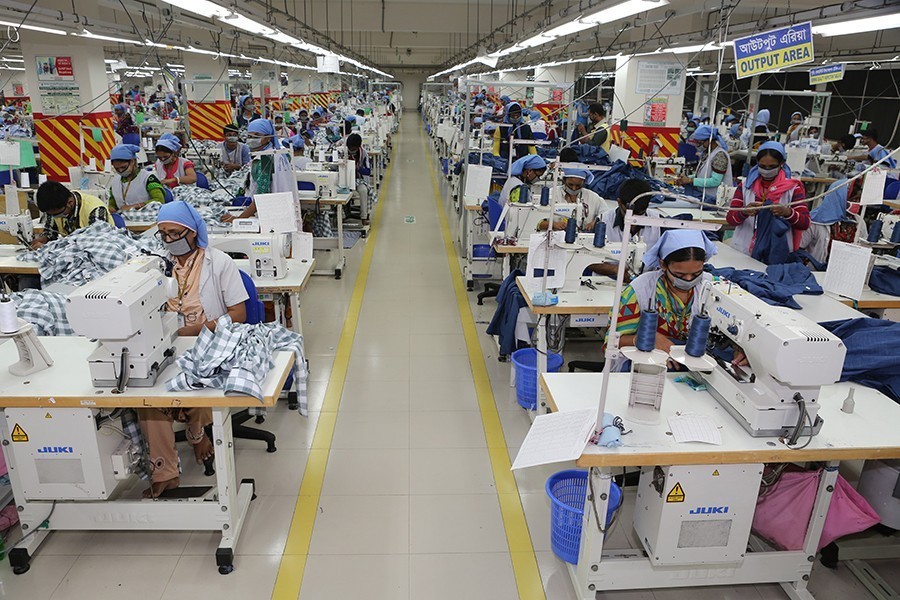Bangladesh, Vietnam benefit most from RMG, footwear shift from China

Published :
Updated :

Bangladesh and Vietnam have benefited most due to the shifting of apparel and footwear exports from China, according to the latest analysis.
It also found that in 2019, both the countries' combined share of apparel and footwear exports to the US and the European Union (EU) equalled half of China's share.
The analysis paper - 'Repeat, Repair or Renegotiate? The Post-Covid Future of the Apparel Industry' - also showed that the US apparel and footwear imports from China declined to 37.9 per cent in 2019, which was 50.7 per cent in 2010.
Similarly, the EU's imports from China declined to 36.1 per cent in 2019, from 47.6 per cent in 2010, according to the study report published on July 21.
Cornell University researchers worked with the International Labour Organisation (ILO) to produce the analysis paper that outlined possible scenarios for a post-COVID future of the global apparel industry, with special attention to the likely impacts for workers, employers and governments in the Asia-Pacific region.
Bangladesh's apparel and footwear exports share to the US increased to 4.3 per cent in 2019, which was 3.5 per cent in 2010. The country's export share to the EU stood at 13.2 per cent in 2019, up from 6.6 per cent in 2010, according to the findings.
On the other hand, Vietnam's export share to the US and the EU rose to 14.9 per cent and 6.7 per cent respectively in 2019. Vietnam's shares to these two traditional markets were 6.6 per cent and 4.0 per cent respectively in 2010.
The study, along with its desk literature review to map existing academic, industry, and financial research related to the apparel industry, interviewed 29 apparel industry experts - regulators, apparel brands and retailers, employers and their organisations, unions and labour rights organisations, and journalists - working in Asia and globally, between August 2020 and March 2021.
Explaining data, the paper noted that as in the US, China remained the EU's largest source of textile, apparel and footwear imports from 2000 to 2019.
It also showed that imports from Vietnam and Bangladesh climbed consistently since 2000, while Turkey's share fluctuated between 9.0 and 14 per cent.
The gradual movement away from the Chinese apparel production was underway before the recent US-China trade battles and 2021 forced labour sanctions. But these developments and supply disruptions in the COVID pandemic revived talk of 'near-shoring' of some apparel production, it added.
Another joint study by the United States Fashion Industry Association (USFIA) and the University of Delaware also revealed that the surging sourcing costs are a significant concern to the US fashion companies in 2021.
It added that the US-China tariff war exacerbates the sourcing cost pressures and financial challenges that the US fashion companies are facing during the pandemic.
Though Vietnam remains a major sourcing destination, the US buyers turn more conservative this year about Vietnam's growth potential due to rising cost concerns and trade uncertainties.
It revealed that Bangladesh is still a lucrative destination for the US buyers because of its price competitiveness.
The USFIA study identified Bangladesh's concentration on basic items as competitive disadvantage.
It predicted that diversifying the export product structure as well as improving production flexibility and agility will be critical for Bangladesh to play a more significant role as an apparel sourcing base for the US fashion companies in the post-COVID world.
When asked, Fazlul Hoque, former president of the Bangladesh Knitwear Manufacturers and Exporters Association (BKMEA), agreed that a number of work orders from China were shifted to the country, but Vietnam is in more advantageous position compared to Bangladesh.
Regarding the US market, he said Vietnam is more focused on the US, while Bangladesh focuses more on the EU for a number of reasons.
Besides, China has investments in Vietnam, thus it can grab major portion of the shifted orders, compared to others including Bangladesh, Mr Hoque explained.
Echoing him, Md Shahidullah Azim, vice president of the Bangladesh Garment Manufacturers and Exporters Association (BGMEA), said Vietnam produces more value added items, which receive comparatively higher prices.
"In contrast, Bangladesh exports large quantity, but gets low prices," he noted, adding that the government should provide policy supports, including incentives, to encourage entrepreneurs to go for producing man-made and other artificial fibres for diversification of local apparel items.
Mr Hoque, however, opined that Bangladesh should look into product diversification and more value added items to grab the larger share of not only China's shifted orders but also overall orders.
Partially deferring with the USFIS findings, he said, "We should give more attention to diversified products, but should not quit manufacturing basic items."


 For all latest news, follow The Financial Express Google News channel.
For all latest news, follow The Financial Express Google News channel.